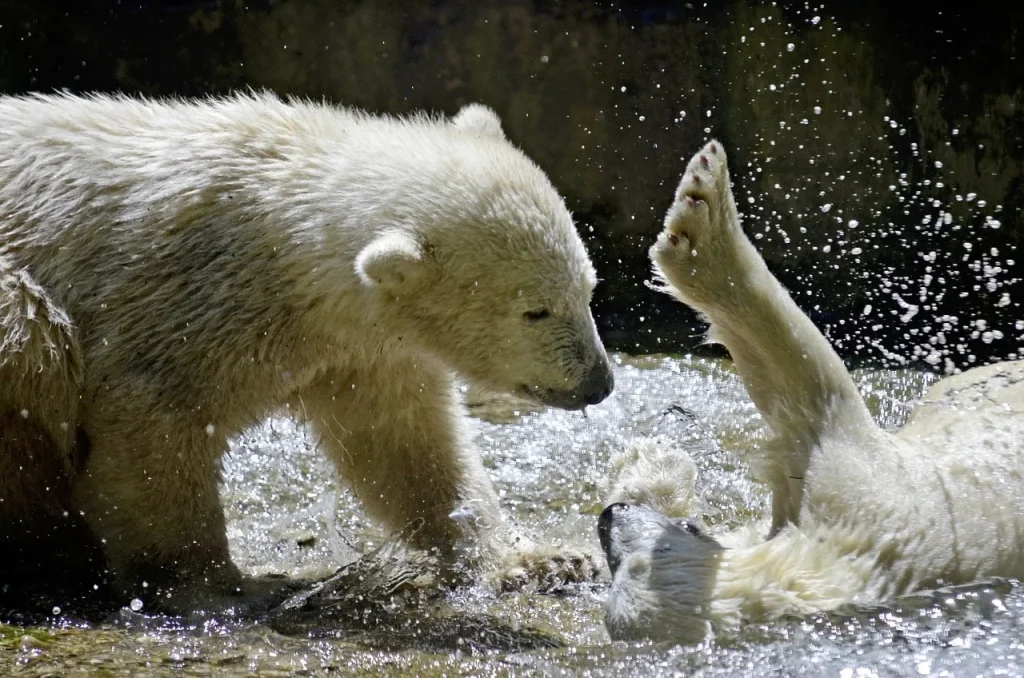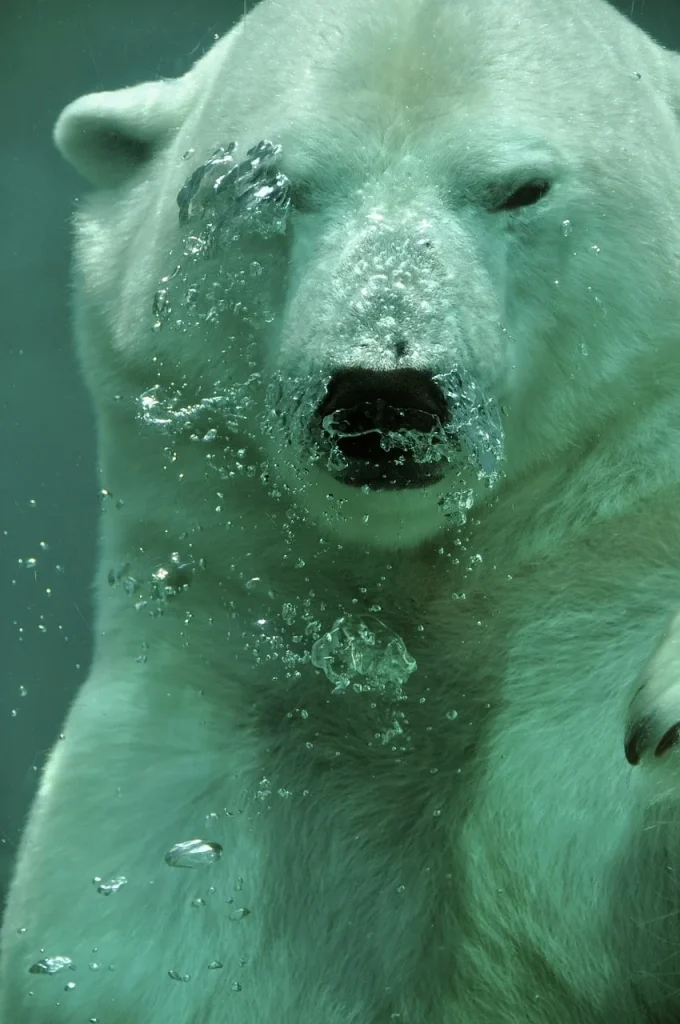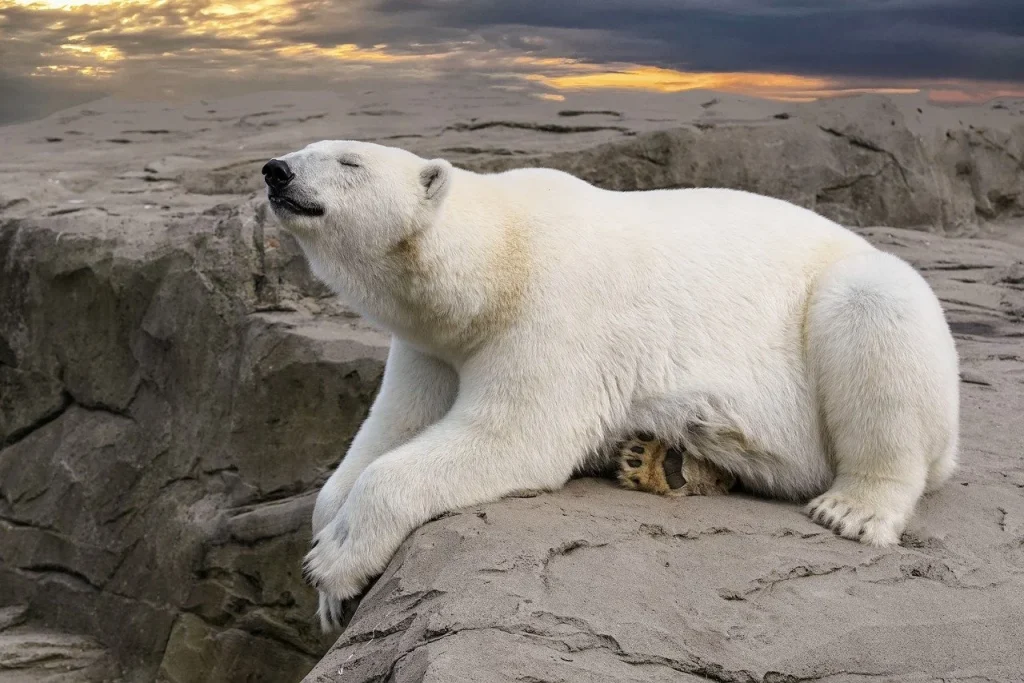Polar bears are more than just the iconic face of the Arctic; they are a marvel of evolution, perfectly adapted to the frigid wilderness they call home. With their thick fur and fat, ability to swim long distances, and unmatched hunting abilities, polar bears are true kings of the Arctic.
This blog will show you some interesting facts about these incredible creatures, shedding light on their survival, behavior, and the challenges they face today.
The polar bear, while surviving in its diminished world, face to face with the unknown, is a model of resilience and adaptation.
Jane Goodall
Polar Bear Facts
Let’s start our journey into the world of polar bears. Read carefully, because I created a quiz at the end of the article to test your expertise on these creatures.
- These creatures can swim continuously for days at speeds over 6 mph.
- Their sense of smell is so keen that they can detect seals nearly a mile away and buried under 3 feet of ice.
- The largest recorded male weighed about 2,209 pounds and was found in Alaska.
- Cubs begin eating solid food at three months old but stay with their mothers for two years.
- Global warming forces them to roam farther in search of food, leading to increased energy expenditures.
- Unlike other bear species, fasting can last over 7 months during the ice-free season.
- Their paws, which act like snowshoes, are 12 inches wide to help distribute weight while walking on ice.
- Each hair shaft is hollow, aiding in buoyancy and insulation.
- They are capable of running up to 25 mph over short distances.
- Pregnant females can increase their body mass by over 200% during gestation.
- The skin underneath their fur is actually black, helping to absorb heat from the sun.
- Aggressive encounters peak during the mating season, when males compete for females.
- They are classified as marine mammals due to their dependence on the oceanic environment for food and habitat.

- These animals have been known to create and use tools for hunting.
- Mother bears are known to adopt orphaned cubs under certain conditions.
- They are one of the few animals that engage in playful behavior throughout adulthood.
- Climate change is reducing their primary prey, forcing them to adapt to alternative food sources like bird eggs.
- Their longevity in the wild averages around 25 years.
- They are the only bear species to be considered a top predator in their environment.
- Cubs are born in a state of extreme prematurity compared to other mammals, weighing only about 1.5 pounds.
- Vocal communications include growls, chuffs, and roars, especially in mother-cub interactions.
- Their sharp claws are curved and non-retractable, measuring up to 3.9 inches long.
- Thermoregulation is achieved through behaviors like swimming and resting in cool spots to avoid overheating.
- Adult males can consume up to 20% of their body weight in a single meal.
- Retinal reflection is absent, suggesting they have adapted to the continuous daylight of the Arctic summer.
- Hybridization events with brown bears are becoming more common as their ranges overlap due to climate change.
- They can swim across water channels up to 60 miles wide without stopping.
- Isotope analysis of their bones shows a diet high in marine proteins.

- Research indicates they do not sleep more during the winter; rather, they remain active year-round.
- Females with cubs are more likely to confront humans than other groups.
- Their home ranges are enormous, with some recorded at over 150,000 square kilometers.
- They are excellent at conserving energy, with a resting heart rate of only about 27 beats per minute.
- Subadults often play-fight, which hones their skills for real combat and hunting as adults.
- Young cubs may be preyed upon by wolves and other polar bears.
- Their sense of hearing is comparable to that of humans, helping them detect prey in harsh weather conditions.
- Culturally, they are significant in the folklore and traditions of Indigenous Arctic communities.
- Mating involves intense competition, with males often fighting severe battles that can lead to serious injuries.
- Due to their solitary nature, interactions are primarily during the breeding season or among mothers and cubs.

- Historically, they have been hunted for their fur, meat, and fat, with regulations now in place to protect them.
- Their liver contains lethal amounts of vitamin A, making it poisonous to humans.
- Footprints can be used by researchers to identify individual animals and track their movements.
- Despite their massive size, they are skilled at maintaining almost complete silence during hunts.
- Diving abilities allow them to reach depths of up to 15 feet while stalking prey from beneath the ice.
- Genetic studies show that they evolved from brown bears as recently as 150,000 years ago.
- White fur provides camouflage in their snowy and icy environment, which is crucial for stealthy approaches.
- Population estimates are challenging due to their remote habitats and vast ranges.
- During summer, some become stranded on land and must survive without their primary food sources until the ice returns.
- Their skull is elongated with a narrow braincase, specialized for their carnivorous diet.
- Their swimming endurance is so remarkable that they can traverse hundreds of miles of open water to reach ice or land.
- Zoos around the world struggle to replicate the specific dietary and environmental conditions these animals require, making their captivity challenging.
Polar Bear Myths

Now, let’s clear the air and distinguish fact from fiction. In the next section, we’ll explore common myths about polar bears and reveal the truth behind them.
- Polar Bears Can Only Live in Extreme Cold
Although they are well adapted to cold environments due to their thick fur and fat, they can also tolerate milder conditions. They are found in areas where the climate can be surprisingly variable, not exclusively in extreme cold. - Polar Bears’ Fur is White
It is commonly believed that they have white fur, but their fur is actually translucent. The individual hairs are hollow and clear, and it’s the reflection and scattering of light that makes the fur appear white. - Polar Bears are Pure Carnivores
While they are primarily carnivorous, they are more accurately described as omnivorous. They can occasionally eat vegetation, berries, and kelp, especially when other food sources are scarce. - Polar Bears Have No Natural Predators
This is not entirely true. While adult polar bears are rarely threatened by other animals, young cubs can be vulnerable to wolves and other polar bears. Humans are also considered a significant threat due to habitat disruption and hunting. - Polar Bears are Abundant and Not at Risk
Despite their visibility in the media, they are classified as vulnerable. Their populations are threatened by climate change, primarily due to the loss of their sea ice habitat, which is essential for hunting and breeding.
No products found.
Polar Bear Quotes

We continue with some of my favorite quotes about polar bears. You can always share yours in the comments so I can add them to the list.
Polar bears require ice to reach their prey. Without it, they must swim incredible distances or starve.
Ian Stirling
Ian Stirling, a prominent polar bear researcher, emphasizes the critical dependency of polar bears on sea ice for survival, highlighting the challenges they face with diminishing ice.
We could use up two Earths if everyone lived like polar bears, alone and at a great distance apart.
Bill Bryson
Bill Bryson uses the solitary nature of polar bears as a metaphor to comment on the unsustainable nature of human consumption if spread thinly and expansively like polar bears.
Seeing a polar bear in the wild is like stepping into an old legend.
Sylvia Earle
Sylvia Earle captures the ethereal and majestic presence of polar bears, likening the experience of encountering one in the wild to entering a mythical tale.
The Arctic is an environment that has evolved over millennia, containing some of the largest predators on Earth. Polar bears are one of them.
David Attenborough
David Attenborough points out the evolutionary grandeur of the Arctic environment and its apex predators, like the polar bear, which dominate these icy realms.
If the ice disappears, so does the polar bear.
Steven Amstrup
Steven Amstrup, a leading scientist studying polar bears, succinctly states the direct link between the survival of polar bears and the existence of Arctic ice, underscoring the impact of climate change.
Polar Bear FAQ

As we move into the final section before your quiz, here are some frequently asked questions about polar bears. Read carefully to ensure you’re fully prepared for the challenge ahead!
- Can polar bears breathe underwater?
No, they cannot breathe underwater. They are mammals, just like humans, and need to come up for air when swimming. - Are polar bears endangered?
Yes, they are classified as vulnerable. Their primary threat is the loss of their sea ice habitat due to climate change, which affects their ability to find food. - Can polar bears climb trees?
No, they cannot climb trees. Their large size and body structure are not suited for climbing; instead, they are powerful swimmers and have adapted to life on ice. - Are polar bears omnivores?
They are primarily carnivorous and rely mainly on a diet of seals. However, when their preferred food is scarce, they may eat small amounts of vegetation, making them technically omnivorous. - Can polar bears live in heat?
They are not adapted to live in hot environments. They are specially equipped for cold Arctic temperatures, and high heat can lead to overheating due to their thick fur and fat layers.
No products found.
Polar Bear Trivia

Welcome to our chilling polar bear quiz! Get ready to test your icy knowledge. Remember, if you don’t get any questions right, you might just find yourself on thin ice with the polar bears!
Polar Bear Merch
If you are a true fan of polar bears, then you definitely need to check out our merchandise. You can find T-shirts, hoodies, mugs, and tote bags for your favorite designs. Feel free to check out all the other designs in our shop.
Conclusion
From their snowy camouflage to their status at the top of the food chain, polar bears are wonders of the natural world. As they face the challenges of a changing climate, it becomes increasingly important for us to act in ways that support their survival.
Let’s continue to educate ourselves and others about the importance of protecting these incredible animals. Till next time, stay curious and explore more. Cheers.
4 Sources Used For This ArticleQuestions about Polar Bears – Polar Bear Facts
Facts About Polar Bears – Polar Bear World
Polar Bear – Nwf


